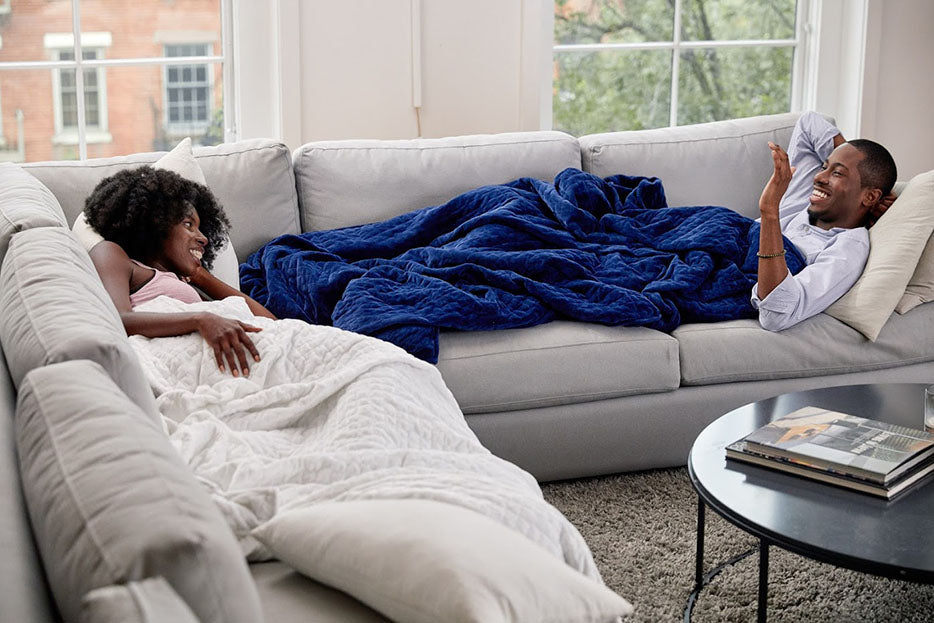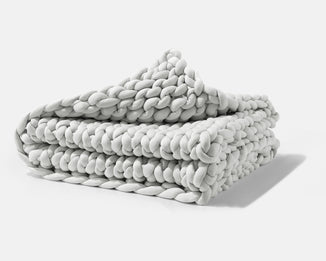
Nov 21, 2022
Is Sleeping On The Couch Good for You?

We've all been there. You're watching a movie and doze off in your comfy weighted robe. You move to the couch after a bout of insomnia to avoid disturbing your partner by tossing and turning. Or visit family for a holiday and get put on the sofa in the living room. And then there's the classic "just resting my eyes" nap that can just as easily happen post-meal during the week or on a Sunday afternoon after shopping.
But regardless of how often it may happen, is it good for you to sleep on the couch?
The quick answer is that sleeping on the couch long-term is not ideal for your health. This is because couches are not designed for sleeping and don't provide the necessary support for your body. Additionally, if you sleep on your couch frequently, it can lead to back and neck pain, as well as other health issues.
Find the Perfect Weighted RobeHow Our Bodies Are Designed to Sleep
To understand why sleeping on the couch might not be the best for you, it's helpful to know a little about how our bodies are designed to sleep and how traditional mattresses meet those needs.

Best Sleeping Positions
Our bodies are designed to sleep in a supine position, which means lying flat on our backs with our heads resting slightly elevated on a pillow and our legs straight. This is the healthiest position for sleeping because it allows our muscles and spine to relax completely. It also reduces the risk of several health issues, including GERD (gastroesophageal reflux disease), sleep apnea and back pain.
When we lie in this position, our head, neck and spine are all aligned, which takes the pressure off these areas and prevents pain. Additionally, this position allows for optimal blood flow and breathing and is great when using a weighted eye mask to keep things dark.
Side sleeping is also considered a healthy sleep position if you have the right mattress. In this position, we can prop our heads with pillows to prevent spinal misalignment and pain. And, like sleeping on our backs, this position allows optimal blood flow and breathing.

As mentioned, side sleeping is only considered a healthy option if you have the right mattress. This is because beds that are too soft can cause our spines to collapse and lead to pain. Conversely, a mattress that is too firm will not contour our curves, which can also lead to discomfort.
Stomach sleeping doesn't tend to be as great for our health as the other positions. This is because it often leads to spinal misalignment and puts pressure on our lower back and neck. As a result, this position is often associated with pain in these areas. It can be difficult to breathe when lying on your stomach, which can cause sleep apnea or worsen it.
While stomach sleeping is not ideal, there are a couple of benefits to this position if you have the right mattress. First, it can help reduce snoring and the effects of sleep apnea by keeping your airways open. However, for many, the drawbacks of this position outweigh the benefits.
The bottom line is that, for the healthiest sleep possible, we should aim to sleep on our backs or sides on a mattress that is neither too soft nor too firm.
Now that we know the ideal sleep positions, let's look at how mattresses are designed to support these positions and how couches compare.

How Mattresses Support Healthy Sleep
As we just discussed, the healthiest positions for sleeping are on our backs or sides. And mattresses are designed to support these positions by providing the necessary level of comfort and support, keeping in mind that there are four main things your body needs to get a good night's sleep:
- A comfortable surface that is neither too soft nor too hard
- A surface that supports your natural spinal curvature
- A surface that allows your body to breathe
- A surface that doesn't cause you to overheat
Mattresses are designed to provide all of these things. They are generally firm enough to support your natural spinal curvature but soft enough to be comfortable. And depending on the type of mattress, they can be designed to further support specific sleep positions like side sleeping.
Additionally, mattresses allow your body to breathe by providing airflow through the material. And many mattresses, especially those made with memory foam, are designed to prevent you from overheating by absorbing and dissipating body heat. Mattresses also come in various sizes to accommodate different body types, sleeping positions and those who share a bed. The most common mattress sizes are twin, full, queen and king.
Now that we know what our bodies need to get a good night's sleep and how many options there are in the world of mattresses and sleep solutions, let's look at how couches compare.

How Couches Compare to Mattresses
Couches are made in various ways, but most are made with a wooden frame, foam and fabric. The frame is often made of solid wood or plywood and is covered in foam to make it more comfortable. In addition, some couches will contain a layer of springs between the frame and the foam to provide extra support. The fabric can be any number of materials. Still, it is often a type of upholstery fabric that is durable and easy to clean.
Couches, much like sofas, come in various shapes and sizes. Here are some of the most common:
- Sectional Couches – Sectional couches are made up of two or more sections that can be arranged in a variety of ways but typically make an L or U shape. They are popular in large rooms and households requiring a lot of seating. A variation on the sectional is modular sofas that allow for even more configuration options, as each piece is a separate unit.
- Standard Couches – Standard couches are the most common type of couch and usually seat three to four people comfortably. They typically measure between six and eight feet long and come in various shapes and styles.
- Loveseats – Loveseats are smaller than standard couches and usually only seat two people. They are often featured in smaller spaces or as an addition to a larger couch in a room.
The average couch will have a seat depth of 21 inches (but as deep as 24 inches), a seat height of 17 to 19 inches, and a back height of 26 to 32 inches. Couches also come in many colors and materials to match any home's style.
When it comes to comparing couches to mattresses for sleeping purposes, the most significant and most obvious differences are:
- Mattresses are available in a wider variety of sizes, giving sleepers more space to move around during the night and a wider variety of sleeping positions.
- The length of couches can be problematic, causing sleepers to curl up in awkward positions or hang off the edge of the couch, which can lead to back and neck pain.
- Mattresses are designed to support the body while lying down, whereas couches are not. This can lead to discomfort and even pain in the back, neck and shoulders when trying to sleep on a couch.
- Mattresses are typically made with more comfortable and breathable materials than those used in couches. For example, latex helps to regulate body temperature and prevents excessive sweating during the night.

- Couches are made with materials designed to be durable and easy to clean, not necessarily for comfort. They can't compare to high thread count sheets and a luxurious weighted blanket cover.
- The springs in a mattress are designed to provide support and distribute weight evenly, while the springs in a couch can cause pressure points and discomfort.
- Many mattresses have a layer of padding on top for additional comfort. In contrast, most couches are designed with cushions that are not as thick and intended to support a seated person.
- You're not as likely to have your preferred pillows, blankets and sheets available when sleeping on a couch, which can lead to a less comfortable sleep.
What About Sleeping on Futons and Sleeper Sofas?
Futon couches are more versatile than other types of couches because they can be used as both a couch and a bed. Their construction varies from that of the typical sofa. Futons typically have a metal frame with a mattress that folds up into the couch during the day. Their frames are lower to the ground, making them easy to convert into a bed. Futon mattresses are usually made of cotton or foam and are not as thick as regular mattresses.
Sleeper sofas are similar to futons in that they can be used as both a couch and a bed. The main difference is that sleeper sofas have a mattress hidden inside the couch and usually look more like or identical to regular couches than futons. You simply pull out the hidden mattress when you want to use the sleeper sofa as a bed. These mattresses are made from various materials, including memory foam, gel and innerspring.
Both futons and sleeper sofas can make great temporary beds, but they're not ideal for long-term use. This is because they're not as comfortable as regular mattresses and don't provide the same level of support. However, if you need a bed for a guest room or a couch that can double as a bed, then a futon or sleeper sofa might be a good option for you.

Futons and sleeper sofas can be great options for small apartments or homes because they don't take up much space and offer extra sleeping accommodations when needed. However, remember that futons and sleeper sofas may be less comfy than regular mattresses and couches. So you might be compromising on comfort and support if you choose either one of these options.
Shop Gravity Weighted BlanketsThe Final Word on Couches for Sleep
A couch can suffice for a night or two, the occasional nap or accidental dozing off. And, yes, having your Gravity weighted blanket on hand will make it more comfortable. But for long-term, regular sleep, we recommend an actual bed with a mattress designed to support your body throughout the night. Of course, a futon or sleeper sofa can also be a good option if you have limited space and need an extra bed for guests.
Remember that mattresses are designed specifically for sleeping and provide the support and comfort needed for a restful night's sleep. Couches simply can't compare.
Image Credits
Your Local Llamacorn/Shutterstock.com
bsd studio/Shutterstock.com
ddok/Shutterstock.com
Your use of this website, its content, and any products obtained through this website is at your own risk. This website, its content, and any products obtained through this website are provided on an “as is” basis, without any warranties of any kind, either express or implied, including warranties of merchantability, infringement of intellectual property, or fitness for any particular purposes. No warranty or representation is made with respect to the completeness, reliability, quality, or accuracy of this website or its content. This website, its content, and any products obtained through this website do not constitute medical treatment and is not a substitute for a medical examination or diagnosis. If you are dealing with a health condition check with your health care provider before using. This website may contain affiliate links that allow us to earn a commission on purchases made through such links. We may accept forms of advertising or sponsorships in connection with this website. There might also be paid topic insertions. We may accept and keep free products, services, and other forms of compensation from others.



